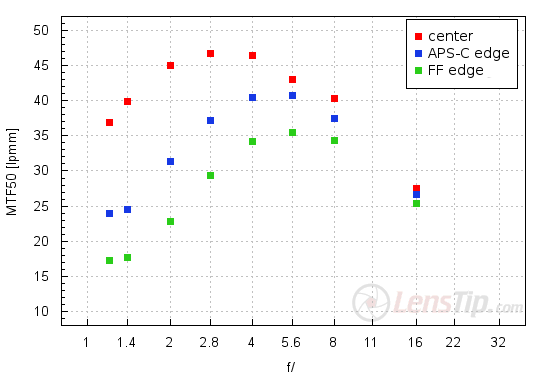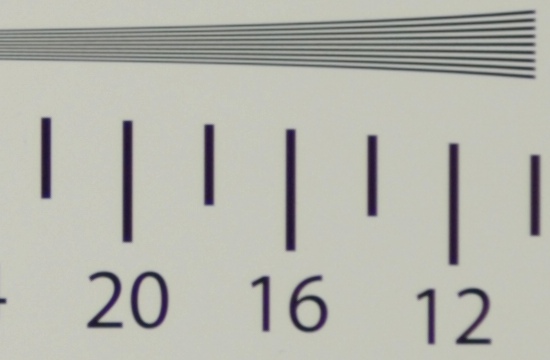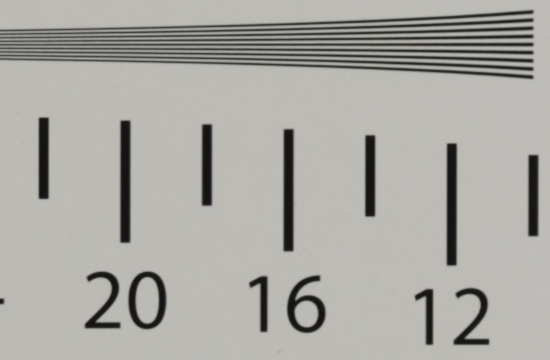Mitakon Speedmaster 85 mm f/1.2
4. Image resolution
Two other lenses worth comparing here are the manual Zeiss Otus 1.4/85 and the Canon EF 85 mm f/1.2 USM II. Both instruments were tested by us on the Canon 1 Ds MkIII; its MTFs are by about 1-2 lpmm lower than those from the Nikon D3x. The Zeiss near the maximum relative aperture got to 40 lpmm and its best result amounted to almost 48 lpmm. The Canon by f/1.2 reached 30 lpmm when wide open and it could get close to 46 lpmm at the most.
There will be no problems with a comparison to the manual Samyang 1.4/85 which was also tested on the Nikon D3x. In its case the maximum relative aperture provided a result a bit over 28 lpmm and the best result was about 38 lpmm. Also the Nikkor AF-S 85 mm f/1.4G was tested on the D3x; its resolution at the maximum relative aperture amounted to 30 lpmm and on significant stopping down it could reach as high as 44.5 lpmm.
Please Support UsIf you enjoy our reviews and articles, and you want us to continue our work please, support our website by donating through PayPal. The funds are going to be used for paying our editorial team, renting servers, and equipping our testing studio; only that way we will be able to continue providing you interesting content for free. |
- - - - - - - - - - - - - - - - - - - - - - - - - - - - - - - - - - - - - - - - - - - - - - - -
Let’s check how the Mitakon compares to that wide array of lenses. Its results in the frame centre, the edge of the APS-C/DX and full frame are presented below.

We are not going to tarry about presenting the most important information: in the frame centre at the maximum relative aperture the Mitakon got an excellent result of almost 37 lpmm which makes it noticeably sharper than the expensive Canon! By f/1.4 you see almost 40 lpmm so the Speedmaster is just slightly worse than the brilliant Zeiss Otus 1.4/85. The maximum results, amounting to about 46.5 lpmm, can be observed by f/2.8-4.0. They are, within a margin of error, in accordance with the performance of the Canon 1.2/85. Overall the Mitakon fares in the frame centre in an excellent manner. Near the maximum relative aperture it is sharper than the Canon 1.2/85 and the maximum possible performance of both instruments remains practically the same. What’s more, by all apertures the Mitakon was definitely better than the Nikkor AF-S 1.4/85, not giving that lens a sporting chance of winning.
Now let’s check the situation on the edge of the APS-C/DX sensor; it isn’t so rosy anymore. Obviously the constructors of the Mitakon focused on excellent results in the frame centre only. By f/1.2-1.4 the images provided by the lens can hardly be called useful. A decent image can be obtained only close to f/1.8 but afterwards the MTFs increase very sharply, near f/4.0-5.6 reaching a very high level of 40 lpmm. The results here are practically identical with the performance of the Canon 1.2/85 USM II. The Nikkor fares a lot better for a change - on stopping down to f/5.6 it can reach 42.5 lpmm so a bit higher than its rivals.
The edge of full frame is of course even more demanding so to make the image useful you have to close the tested lens down to f/2.8. However the Mitakon once again is better than then Canon 1.2/85 because that lens had to be stopped down to nearly f/3.5. The comparison of the maximum values allows us to proclaim a draw. The Mitakon exceeds a level of 35 lpmm and the Canon reaches almost 34 lpmm but the difference between the sensors, used in those two tests, means the results are almost precisely the same. Once again the Nikkor showed its strength, exceeding a level of 30 lpmm already by f/2.0
The summary of the Mitakon performance in the resolution category cannot be other than enthusiastically good. In the frame centre it is sharper than the Canon and on the edge it’s neck and neck. What’s more the difference between the Mitakon and the brilliant Zeiss Otus 1.4/85 remains really slight. When you compare it to the manual Samyang 1.4/85 you find out it is better practically in every place.
Finally one more thing. The Mitakon Speedmaster 0.95/35, tested by us before, had a slip-up with aperture values marks which were misleading. As the 1.2/85 model also features a click-less aperture ring we decided to check whether its markings are correct. The results of our measurements are presented below in a form of a chart.
|
|
|
|
|
|
|
|
|
|
|
|
|
|
|
|
|
|
|
|
|
|
|
|
|
|
|
It is clear that in the aperture range from f/1.2 to f/4.0 everything is in full accordance. It is a piece of very good news; after all in such an instrument these apertures are used the most often. For smaller relative apertures the real values are a bit higher than the markings but the differences aren’t huge, reaching about 1/3 EV. It is definitely lower than 1.5 EV you see in the case of the Speedmaster 0.95/35 so this time there are no reasons to complain.
At the end of this chapter traditionally we present crops taken from photos of our resolution testing chart saved as JPEG files along with RAW files, used for the analysis above.
| Nikon D3x, JPEG, f/1.2 |
 |
| Nikon D3x, JPEG, f/4.0 |
 |






